Now That’s A Mirliton Vine!
Here are some photos of Kevin Boutte’s mirliton vines in the Teche area of Louisiana
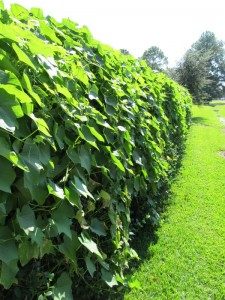

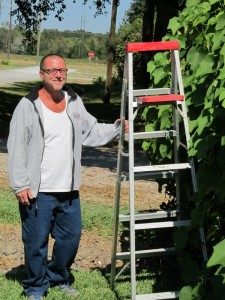
MIRLITON.ORG
Here are some photos of Kevin Boutte’s mirliton vines in the Teche area of Louisiana



Jeanette Bell is doing some remarkable work on bringing fresh food to inner-city neighborhoods in New Orleans. I first learned about her work from this short video about her mirliton vine in her Fleur d’Eden on Baronne street in New Orleans. It turns out that she received her mother plant from Pam Broom last year (see below), which means that it was the “Joseph Boudreaux” Louisiana heirloom variety that we provided to Pam two years ago. Jeannette distributed 70 plants from her mother plant last year, so the Boudreaux variety in expanding exponentially in New Orleans! Jeannette also runs the Garden On Mars project that instructs people how to convert abandoned lots into urban gardens. Here is a recent article on Jeanette’s work.

Jeannette Bell
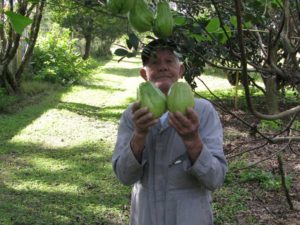
(Joseph Boudreaux with his home-grown mirliton variety)
Part of the inspiration for forming Mirliton.Org was the impact of Hurricane Katrina on New Orleans the the Louisiana coastal parishes. Mirliton plants will die if the roots are submerged in water for more than 48 hours: The Katrina flood destroyed all the vines in flooded areas in New Orleans and some coastal parishes.
To renew the tradition of backyard mirliton growing, we had to find traditional heirloom mirliton varieties grown outside New Orleans. The mirlitons sold commercially in grocery stores (as Chayote) could not be used as seed: they are largely imported from high altitude sites in Costa Rica and Mexico and although they will sprout and grow a few stems, like many high-altitude plants, they normally succumb to our unique growing environment and plant diseases.
Since 2007, we have searched for growers of what we call traditional “Louisiana heirloom mirlitons” by advertising in the Louisiana Department of Agriculture publication “Market Bulletin” and contacting Parish (county) Agricultural Extension Service staff–thanks to the assistance of the Louisiana State University extension service. We also simply drove the roads along the bayous where mirlitons were traditionally grown on bayou banks (that’s how we found the Mister Rock mirliton variety).
We eventually found growers who had been growing the same variety for decades, although they are few and far between and a disappearing breed. With the discovery of these growers–most of them older gardeners in their eighties who were upholding a family tradition of mirliton growing, we knew now that the traditional locally-grown varieties would once again thrive in New Orleans and rest of the state.
These growers would donate seed mirlitons to re-seed New Orleans and, as the demand grew, we would also buy from growers and give away the seed as sprouts and plants. As word spread of our project (which began under the name “Adopt-A–Mirliton”), we ended up distributing seed throughout Louisiana, Texas, Mississipi, and Alabama. We decided to feature some of the success stories on this blog from time to time.
In 2010 a reader of the Market Bulletin called me and said he knew of a grower in Broussard, Louisiana who had several vines of the same variety that he had been growing for decades. I visited Joseph Boudreaux in Broussard and he donated a few of his mirlitons and I purchased several more. Later, after an early freeze, he donated a few dozen freeze-damaged fruit that he assured us would germinate and grow: he was right.
We always name the variety after the person we first found growing it so that we can track the variety’s progress as we distribute it throughout the region; heirloom varieties have different qualities that we are testing for, such as fruiting habits and disease resistance. Naming the variety also allows us to find new growers who will “adopt” a specific variety and commit to growing it so that we will always have a reliable seed source and can preserve the genetic diversity of the locally grown varieties.
In 2011, Mirliton.Org donated three container plants of the Joseph Boudreaux variety to Sun Harvest Garden in New Orleans on Oretha Castle Haley Boulevard. A small Central City community garden built on a cleared lot, Sun Harvest is run by Pam Broom, a long-time community activist and urban farming advocate. Planted in the spring of 2011, the vine produced a small crop later that fall. During the warm winter of 2012 (we never got a frost in central New Orleans), Pam harvested even more fruit and the plant is still producing during the traditional spring crop cycle.
Pam has distributed some of the the new fruit as seed to other gardeners in the area and her vine is, as mirlitons are inclined to do, rapidly taking over more of her garden. But she’s happy with the prolific new arrival. “One of the things that inspires me most about receiving mirliton plants from Mr. Joseph Boudreaux,” says Pam, “is that thanks to him, I am experiencing growing a beautiful, sweet and delicious variety in the heart of the City of New Orleans.”
From Broussard to New Orleans: mirlitons are making a comeback thanks to people who appreciate this iconic Louisiana plant.

Pam Broom with her Joseph Boudreaux mirliton variety vine at the Sun Harvest Garden in New Orleans
Lance Hill
Mirliton.org
The hot and rainy weather has brought out the annual anthracnose disease for mirlitons. See the last summer’s blog entry here on this disease (I have added a photograph and link to more photos) which discusses how to recognize the different signs of powdery mildew and anthracnose. The growers guide on the web site has additional information. Anthracnose infects almost all mirliton plants, especially in their first year, but depending on proper care and hopefully a low rate of evening rain showers, the disease will only affect a few stems and when those die, new stems will return.
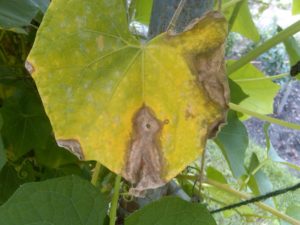
Mirliton leaf infected with anthracnose plant disease. Note different browning pattern and the distinctive “shot hole” in the middle of the brown tissue, which does not occur with powdery mildew (anthracnose, unlike powdery mildew, can live on dead plant tissue and literally “eat a hole” through the plant)
I just posted to our FAQ page a comprehensive article on powdery mildew in Mirlitons. I tried to get it to fit on the blog but apparently blogs are for concise thinkers–that rules me out. Visit the FAQ page and Garden Blog for new useful information.
Lance Hill, Mirliton.Org
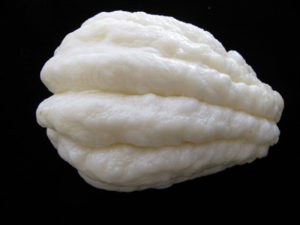
Ishreal Thibodeaux Variety Mirliton. This is the only pure-white mirliton that we know of in the South.

Mirlitons (Sechium edule) in the United States south have two main fruiting seasons that begin after the spring and fall equinox, which generally means flowering begins in May for several weeks and again in October until December. The plant initiates flowering in response to leaf signals when leaves detect equal periods of light and darkness (photoperiodism). This stimulus is combined with temperature changes (thermoperiodism) in the fall: a cold snap after the equinox can help stimulate flowering. Spring crops are normally much smaller than the fall crop.
This early crop has created an opportunity to use the winter/spring fruit for seed. But these cool-weather mirlitons can be a little cranky if panted in hot weather.
Spring fruit can be used as seed but must be planted using special methods. The goal is to get the sprouts into the ground as soon as possible so they can develop a root structure sufficient to meet the water needs of the top growth when temperatures reach 90 °F as early as May. Unlike containerized plants or seeds that were planted the previous fall, these sprouts begin the summer with no root structure.
Spring fruit should be allowed to mature for at least three weeks on the vine and meet the “thumbnail test”: press your thumbnail into the skin and if the fruit flesh is soft and the nail leaves a dent, then the fruit is not ready to pick. Also if you are familiar with the heirloom variety that you are growing, you will know the average size of a mature fruit. The fruit must be mature to be able to germinate and sprout.
Hot Weather Planting of Sprouts:
During normal growing cycles, the fruit may not be ready to pick until late May and won’t sprout until June or later. Temperatures over 90°F. can suppress shoot and root development and dehydrate the seed fruit that is exposed to the sun. I’ve done that in the past–planted a sprout in June and watched it sit there and do nothing. When I excavated it, I saw how distressed the seed had become by the scorching sun. Instead of coming up, the shoot stayed below ground and wound in a circle.
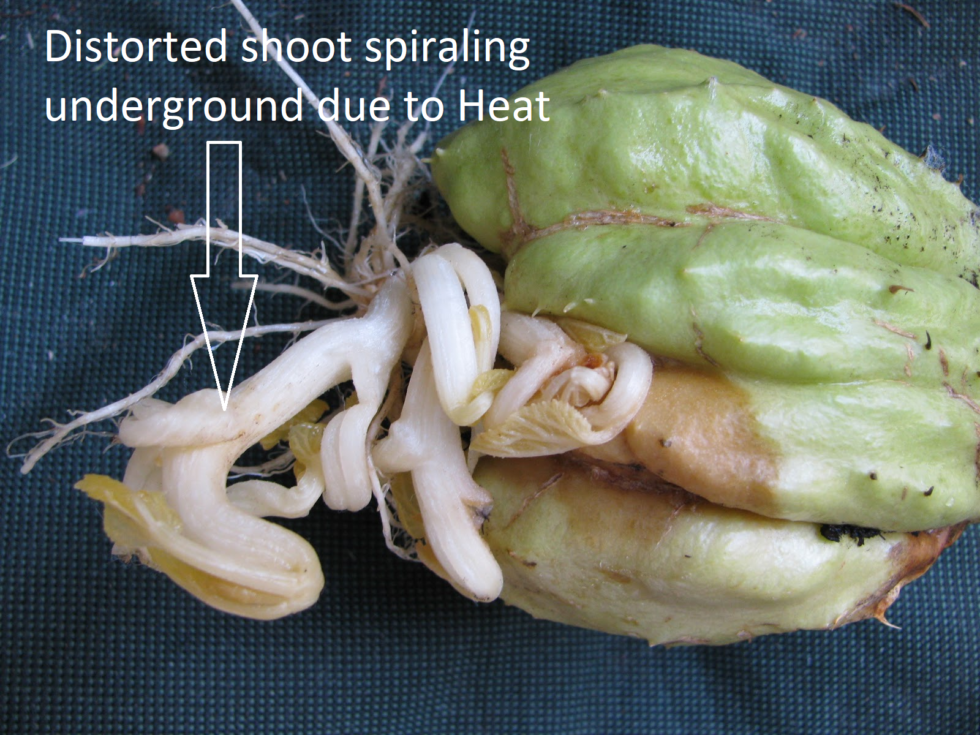
So sprout-planting in May and June should be done as you normally would, but place a milk crate over the planted sprout and cover it with shade cloth. This will protect it from the intense solar heat. The milk crate will also protect the mirlitons from squirrels and other rodents that like tender young fruit.
Once the shoot begins to grow, you can remove the crate and stake the vine.
Recent Comments